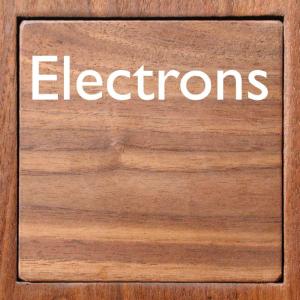 Lichtenberg figure. Lichtenberg figure.
You can't really see electrons directly, in the same way you can see a lump of carbon, say. On the other hand, you might say that when you're looking at a lump of carbon, or any other element for that matter, it's the electrons you're seeing, since they are what interact with light, not the nucleus. And when you pick up a sample of any element, it's the electrons you're feeling, because it is electrostatic repulsion between the electrons in the sample and the electrons in you that cause it to push back at you when you squeeze it. In fact, every physical interaction you have with the world involves exclusively contact and forces between electrons, or electrons interacting with photons. (The only exception being when you pick up something radioactive.)
Although they are everywhere, it's hard to bottle up a bunch of electrons and keep them as a sample. Hard, but not impossible: You can have them in a capacitor or stuck on a metal electrode in a vacuum and keep them there for months or years on end. But it looks sort of boring.
Another way is to bottle them up in an insulating material, like acrylic, and then let them loose all of a sudden. This "Lichtenberg figure" is made by using a particle accelerator to accelerate electrons to very, very high speeds (about 0.9987 times the speed of light, or about 299400km/s) and inject them deep into a block of acrylic (about 5 inches tall in this case). You keep pumping in more and more electrons until so many have built up that the plastic just can't take it any more and suddenly there is a loud bang as the charge comes flooding out all at once, leaving the trails of fractured plastic you see preserved here. In other words, it's a frozen lightening discharge, preserving in minute detail the path taken by the huge built up charge as it left the plastic. (Thanks to Eric Weisstein for the calculation of the speed of 10MEv electrons.)
Be sure to click on the Rotatable Image icon at the top right of this description: It takes you to a really nice QuickTime VR rotatable image of this figure, lit in such a way that you can see the fine filaments very nicely. It's about a 7MB download but worth every byte. (Unless you don't have QuickTime installed, in which case it's not worth anything.)
This website has interesting information about the method for making them, and an email address from which you may order one of the very limited supply currently available. Right now they have a limited supply of Lichtenbergs made in the 1970's available: When these are gone there will be no more until they get more time on an electron accelerator, which may or may not happen later this year.
Bert Hickman, operator of the website, has this to say on the availability of Lichtenberg figures:"Unfortunately, e-beam accelerators are very costly. Getting affordable time on these systems to make Lichtenbergs has become considerably more difficult since 9/11. The source for cylindrical Lichtenbergs has (temporarily?) dried up. Availability of the appropriately prepared raw material and scarce e-beam accelerator time are preventing further creation of block style Lichtenbergs. Hopefully these issues will be resolved later this year. Unfortunately, there are currently no other known sources for Lichtenbergs." If you're interested in obtaining a Lichtenberg figure (and who wouldn't be?), visit lichtenberg.teslamania.com or check out their current eBay auctions.
Source: Anthony J. DeAngelis
Contributor: Theodore Gray
Acquired: 1 January, 2003
Text Updated: 11 August, 2007
Price: $28
Size: 5"
Purity: 0%
|
| 
|
|